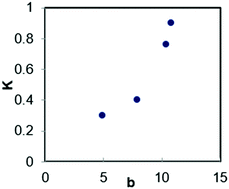Self-diffusion of a highly concentrated monoclonal antibody by fluorescence correlation spectroscopy: insight into protein–protein interactions and self-association†
Abstract
The dynamic behavior of monoclonal antibodies (mAbs) at high concentration provides insight into protein microstructure and protein–protein interactions (PPI) that influence solution viscosity and protein stability. At high concentration, interpretation of the collective-diffusion coefficient Dc, as determined by dynamic light scattering (DLS), is highly challenging given the complex hydrodynamics and PPI at close spacings. In contrast, self-diffusion of a tracer particle by Brownian motion is simpler to understand. Herein, we develop fluorescence correlation spectroscopy (FCS) for the measurement of the long-time self-diffusion of mAb2 over a wide range of concentrations and viscosities in multiple co-solute formulations with varying PPI. The normalized self-diffusion coefficient D0/Ds (equal to the microscopic relative viscosity ηeff/η0) was found to be smaller than η/η0. Smaller ratios of the microscopic to macroscopic viscosity (ηeff/η) are attributed to a combination of weaker PPI and less self-association. The interaction parameters extracted from fits of D0/Ds with a length scale dependent viscosity model agree with previous measurements of PPI by SLS and SAXS. Trends in the degree of self-association, estimated from ηeff/η with a microviscosity model, are consistent with oligomer sizes measured by SLS. Finally, measurements of collective diffusion and osmotic compressibility were combined with FCS data to demonstrate that the changes in self-diffusion between formulations are due primarily to changes in the protein–protein friction in these systems, and not to protein–solvent friction. Thus, FCS is a robust and accessible technique for measuring mAb self-diffusion, and, by extension, microviscosity, PPI and self-association that govern mAb solution dynamics.



 Please wait while we load your content...
Please wait while we load your content...